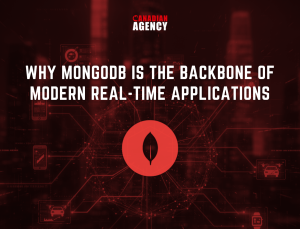In today’s fast-paced digital world, where users demand flawless interactions, instant responses, and a real-time feedback loop, it is crucial to select a database that meets the expectations of modern applications. One database that has emerged as a backbone for many of these systems is MongoDB — a document-oriented, NoSQL datastore that offers the agility, scalability, and responsiveness modern apps need.
This blog explores why MongoDB is well-suited for the real-time space, what architectural features make it powerful, and how it’s used in real-world applications — including one of our project, Phantom Disposal — before concluding with practical best practices.
The Real-Time Imperative
Modern applications — from mobile apps and IoT systems to logistics, dashboards, and e-commerce — no longer tolerate minute-level update delays. They require sub-second latency across every layer: the frontend, database, and analytics engine.
These environments share common traits:
- High data velocity: Chat messages, location updates, and streams of sensor data.
- Regular schema changes: Data structures, metrics, and features change quickly.
- Elastic scalability: Needs to manage spikes in traffic, such as Black Friday or IoT event surges.
- Continuous analytics: driver routing, real-time dashboards, and fraud detection.
- Constantly accessible: Revenue and user confidence are lost due to downtime or latency.
Traditional relational databases suffer because of their inflexible schemas, restrictions on vertical scaling, and slower write speeds. MongoDB, on the other hand, does well in these circumstances.
What is MongoDB?
MongoDB is a document-oriented NoSQL database that stores data in JSON-like (BSON) documents rather than rigid tables. According to Oracle, “MongoDB saves data in JSON documents… its flexible model allows developers to store unstructured data while offering indexing and replication for speed and reliability.”
Introduced in 2009 by 10gen (now MongoDB Inc.), it has evolved to support multi-document ACID transactions, distributed clusters, and native cloud services. MongoDB is a preferred option for online and mobile developers who value flexibility and quick iteration because it is a key component of the well-known MERN/MEAN stacks.
Why MongoDB Excels for Real-Time Applications
a) Flexible Document Model
Developers may represent complex entities in a single record, including activity logs, user profiles, and preferences because of MongoDB’s schema-less document architecture.This lessens the requirement for costly migrations or joins. According to CData, MongoDB’s adaptable schema allows for “dynamic model changes without downtime,” which is essential for real-time products and allows for agile feature releases.
b) High Throughput and Low Latency
MongoDB’s distributed architecture and sharding support high write throughput and fast reads. It can handle massive, concurrent workloads typical of IoT or live dashboards. According to MongoDB’s benchmarks, version 8.0 delivers “up to 36% better throughput” and “200% faster performance on time-series aggregations.”
c) Change Stream-Based Real-Time Analytics
Change streams, triggers, and GraphQL subscriptions in MongoDB enable applications to respond instantly to data changes. Dashboards, in-app metrics, and real-time notifications are made possible by apps’ ability to listen for changes rather than poll. This feature transforms MongoDB from a passive data repository to a real-time event engine.
d) Built-in Replication & Global Distribution
High availability is vital in real-time systems. MongoDB’s replica sets automatically replicate data across multiple nodes, ensuring continuity even if one node fails. By deploying clusters across regions global access with minimal latency is made possible. “MongoDB’s replication ensures no single point of failure,” as stated by Medium.
e) Developer Productivity
MongoDB integrates naturally with modern stacks like Node.js, React, and Python, since its document structure aligns with JSON. This eliminates translation overhead and accelerates development — a key advantage for agile, microservice-driven teams.
f) Unified Operational & Analytical Workloads
Unlike traditional databases that separate transactions (OLTP) and analytics (OLAP), MongoDB supports both on a single platform. With aggregation pipelines and time-series capabilities, teams can analyze live data while processing operational requests, thereby cutting costs and simplifying their architecture.
Case Study: Real-Time Power in Action — Phantom Disposal
A strong real-world example of MongoDB’s capabilities can be seen in one of our client projects — Phantom Disposal.
Project Overview:
Phantom Disposal simplifies junk removal through real-time coordination between customers, drivers, and dispatchers. Built using React Native, Redux Toolkit, and Socket.IO, the app depends on continuous, real-time communication.
Backend Stack:
The backend runs on Node.js, React.js, and — crucially — MongoDB for data persistence and real-time updates.
MongoDB’s Role:
- Real-time job tracking: Live driver locations and job statuses are continuously updated.
- Efficient data model: Each “job” document embeds driver info, timestamps, and progress logs.
- Scalability: Sharded collections and replication ensure smooth performance even under heavy load.
- Resilience: Replica sets prevent downtime during peak activity.
This project demonstrates how MongoDB serves as the central data backbone for an application that relies on high-frequency updates, live synchronization, and scalable performance — the hallmarks of an actual real-time application.
Best Practices for Using MongoDB in Real-Time Systems
-
Model Your Data Wisely
- Represent logical entities as single documents when possible (e.g., a “job” with embedded driver and status).
- Avoid deep embedding that grows endlessly — refer to it instead.
- Use capped collections for fast-moving data, such as GPS pings.
- Add compound indexes (e.g., {driverId, timestamp}) and TTL indexes to manage old records automatically.
-
Design for Scalability Early
Make plans for expansion that is horizontal. Sharding in MongoDB enables data to be divided among nodes to manage spikes in write-intensive workloads. Distribute replicas across regions for high uptime and low latency reads for audiences around the world.
-
Leverage Change Streams
When using MongoDB change streams to initiate real-time actions like notifications or dashboard updates polling is not necessary. For event-driven scalability, combine them with messaging platforms like Kafka or AWS SNS.
-
Ensure High Availability
To guarantee constant data availability and dependability, build up replica sets for automatic failover and keep regular backups. Real-time services cannot afford downtime — even a short outage can disrupt user trust and operations.
-
Optimize for Low Latency
Adapt read/write concerns to the priorities of the company. A little looser consistency can significantly speed up response times in some use circumstances. Use MongoDB’s built-in query latency and replication lag metrics to keep an eye on performance.
-
Adopt a Microservices Architecture
For ecosystems that depend on microservices and events, MongoDB is ideal. While using change streams to publish updates, each service may be the owner of its data collections. The dominance of MongoDB in real-time microservices is supported by research (arXiv 2025).
-
Secure and Monitor
Sensitive data is processed by real-time apps, which guarantee role-based access controls, network encryption, and encryption at rest. The latest iterations of MongoDB improve observability and encryption. To sustain performance, monitor throughput, index growth, and cluster balance continuously.
Pitfalls to Watch Out For
MongoDB is robust but not flawless. Keep these caveats in mind:
Consistency trade-offs: As a distributed system, MongoDB defaults to the BASE model (Basically Available, Soft state, Eventually consistent). Configure write concerns carefully if strict ACID compliance is needed.
Schema discipline: Poor document or index design can cause performance degradation.
- Sharding complexity: Shard only when scaling demands it; managing shards adds operational overhead.
- Document growth: Overly large documents can bloat storage and hurt query speed.
- Hybrid architectures: Consider connecting MongoDB with a lake or data warehouse for intensive batch processing for large-scale analytical applications.
Conclusion
The foundation of contemporary real-time applications is MongoDB. It is perfect for today’s data-driven applications due to its distributed design, flexible schema, and integrated real-time functionality. MongoDB gives developers the ability to provide quick, dependable, and responsive user experiences for everything from logistics dashboards to IoT systems and collaborative tools.
Our Phantom Disposal project perfectly illustrates these strengths — combining Node.js, React Native, and MongoDB to enable continuous background tracking, job management, and dispatch synchronization in real time.
In a world where every millisecond matters, the question isn’t whether to use MongoDB — it’s how to use it effectively. With thoughtful design, scalability planning, and intelligent monitoring, MongoDB can power the kind of responsive, data-rich experiences that modern users expect.




